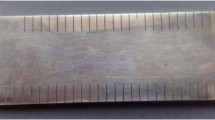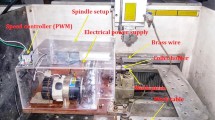Abstract
In this work, using zinc-coated copper wire and uncoated brass wire, WED machining performance of IN718 was evaluated with input process variables, the discharge duration, pulse interval time, and wire runoff speed. The output variables analyzed are wire feed rate, kerf width, and recast layer characteristics. The experimental results show that zinc-coated copper wire is better in general performance when compared with uncoated brass wire. With the optimization of WEDM process parameters for the zinc-coated copper wire, it obtained 35% increase in wire feed rate and a reduction of 40% in wire consumption. When WEDM at optimized conditions with uncoated brass wire, it was found that 36% gain on wire feed rate with 80% reduction of wire consumption. Electrode material (Cu and Zn) from both wires was incorporated in the IN718 recast layer and in direction to matrix material. The kerf width is dependent on the discharge energy and wire runoff speed.
Similar content being viewed by others
References
Parida AK, Maity K (2018) Comparison the machinability of Inconel 718, Inconel 625 and Monel in hot turning operation. Engineering Science and Technology, an International Journal 21:364–370
Aka E, Gursel A (2015) A review on supperalloys and IN718 nickel-based INCONEL superalloy. Periodicals of engineering and natural sciences 3(1):15–27
Ezugwu EO, Wang ZM, Machado AR (1999) The machinability of nickel based alloys: a review. J Mater Process Technol 86:1–16
Sims CT, Hagel WC (1972) The superalloys. Wiley-Interscience, New York, p 614
Richards N, Aspinwall D (1989) Use of ceramic tools for machining nickel-based alloys. Int J Mach Tools Manuf 29(4):575–588
Field M (1968) Machining aerospace alloys, iron and steel institute, special report, 94: 151–160
Warburton P (1967) Problems of machining nickel-based alloys. Iron and Steel Institute, Special Report 94:151–160
Ho KH, Newman ST, Rahimifard S, Allen RD (2003) State of the art in wire electrical discharge machining (WEDM). Int J Mach Tools Manuf 44:1247–1259
Dabade UA, Karidkar SS (2016) Analysis of response variables in WEDM of Inconel 718 using Taguchi Technique. Procedia CIRP 41:886–891
Klocke, F, Schneider, S, Frauenknecht, B, Hensgen L, Klink, A, Osswald, K, (2018), Thermographic analysis of spark location distribution in sinking EDM, 19th CIRP conference of electro physical and chemical machining, 68:280–285
Schumacher B (2004) After 60 years of EDM the discharge process remains still disputed. J Mater Process Technol 149:376–381
Li L, Guo YB, Wei XT, Li W (2013) Surface integrity characteristics in wire-EDM of inconel 718 at different discharge energy. Procedia CIRP 6:220–225
Mouralova K, Kovar J, Klakurkova L, Prokes T (2018) Effect of width of kerf on machining accuracy and subsurface layer after WEDM. J Mater Eng Perform 27(4):1908–1916
Amorim FL, Weingaertner WL (2004) The influence of generator actuation mode and process parameters on the performance of finish EDM of a tool steel. J Mater Process Technol 166(3):411–416
Lottgen R (1998) EDM die sinking—state of the art, in: proceeding 12th international symposium for electromachining, Aachen, Germany, 341–350
Masuzawa T (2001) Micro-EDM, proceeding of 13th symposium for electromachining – ISEM XIII, 1:3–18
Deng D, Peng RL, Brodin H, Moverare J (2017) Microstructure and mechanical properties of Inconel 718 produced by selective laser melting: sample orientation dependence and effects of post heat treatments. Mater Sci Eng A 713(294–306):2018
Zhang D, Feng Z, Wang C, Wang W, Liu Z, Niu W (2018) Comparison of microstructures and mechanical properties of Inconel 718 alloy processed by selective laser melting and casting. Mater Sci Eng A 724(100):357–367
Amorim F, Rempel F (2005) Wire electrical discharge machining of thin Ti6Al4V plates : rough machining assessment, 18th international congress of mechanical engineering. Ouro Preto, MG Brazil, 1: 1–12
Ramakrishnan R, Karunamoorthy L (2008) Modeling and multi-response optimization of Inconel 718 on machining of CNC WEDM process. J Mater Process Technol 207(1–3):343–349
Convers D, Balley J (1981) Electrode for electrical discharge machining. US patent, Nr 4 341 939
König W, Klocke F (1997) Fertigungsverfahren - 3: abtragen und generieren. Berlin: Springer, 3v
Werner A (2016) Method for enhanced accuracy in machining curvilinear profileson wire-cut electrical discharge machining. Precis Eng 44:75–80
Miller SF, Kao CC, Shih AJ, Qu J (2005) Investigation of wire electrical discharge machining of thin cross-sections and compliant mechanisms. Int J Mach Tools Manuf 45(15):1717–1725
VDI - Verein Deutscher Ingenieur (1990) Elektroerosive bearbeitung:definitionen und terminologie 3402 . Düsseldorf, 2 v
Aspinwall DK, Soo SL, Berrisford AE, Walder G (2008) Workpiece surface roughness and integrity after WEDM of Ti-6Al-4V and Inconel 718 using minimum damage generator technology. CIRP Ann Manuf Technol 57(1):187–190
Dibitonto DD, Eubank PT, Patel MR, Barrufet MA (1989) Theoretical models of the electrical discharge machining process I: a simple cathode erosion mode. J Appl Phys 66(9):4095–4103
Eubank PT, Patel MR, Barrufet MA, Bozkurt B (1993) Theoretical models of the electrical discharge machining process III: the variable mass, cylindrical plasma mode. J Appl Phys 73(11):7900–7909
Author information
Authors and Affiliations
Corresponding author
Rights and permissions
About this article
Cite this article
Reolon, L.W., Henning Laurindo, C.A., Torres, R.D. et al. WEDM performance and surface integrity of Inconel alloy IN718 with coated and uncoated wires. Int J Adv Manuf Technol 100, 1981–1991 (2019). https://doi.org/10.1007/s00170-018-2828-6
Received:
Accepted:
Published:
Issue Date:
DOI: https://doi.org/10.1007/s00170-018-2828-6




